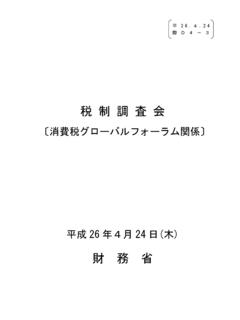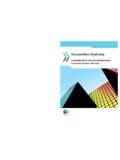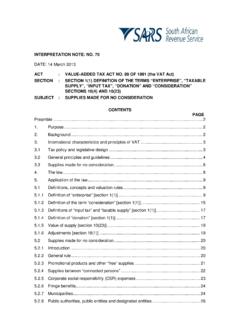Transcription of International VAT/GST Guidelines - OECD
1 THIRD MEETING OF THE OECD GLOBAL FORUM ON 1. Core Features of value added Taxes Covered by the GuidelinesChapter 2. Neutrality of value added Taxes in the Context of Cross-Border TradeChapter 3. Determining the Place of Taxation for Cross-Border Supplies of Services and IntangiblesChapter 4. Supporting the Guidelines in Practice: Mutual Co-operation, Dispute Minimisation, and Application in Cases of Evasion and AvoidanceInternational VAT/GST GuidelinesINTERNATIONAL VAT/GST Guidelines 1 International VAT/GST Guidelines November 2015 2 3 4 5 TABLE OF CONTENTS PREFACE CHAPTER 1: Core Features of value added Taxes Covered by the Guidelines A. Overarching purpose of a VAT: A broad-based tax on final consumption B. The central design feature of a VAT: Staged collection process C.
2 VAT and International trade: The destination principle D. Application of generally accepted principles of tax policy to VAT: The Ottawa Taxation Framework Conditions CHAPTER 2: Neutrality of value added Taxes in the Context of Cross-Border Trade A. Introduction B. Basic neutrality principles C. Neutrality in International trade Taxation principles Administration and compliance D. Applying the VAT neutrality principles in the context of cross-border trade: Commentary on the Guidelines on neutrality Principles of good tax administration Reciprocity Groups of countries Commentary on the Guidelines Commentary on Guideline Commentary on Guideline Similar levels of taxation Businesses in similar situations Similar transactions Summary Commentary on Guideline Commentary on Guideline Commentary on Guideline Commentary on Guideline 6 CHAPTER 3: Determining the Place of Taxation for Cross-Border Supplies of Services and Intangibles A.
3 The destination principle B. Business-to-business supplies The general rule Defining the general rule Applying the general rule - Supply of a service or intangible to a legal entity with single location Applying the general rule - Supply of a service or intangible to a legal entity with multiple locations Direct use Direct delivery Recharge method Conclusion Commentary on applying the general rule - Supply of a service or intangible to a legal entity with single location Supplies to single location entities Supplier The determination of the place of taxation is not affected by any onward supply The determination of the place of taxation is not affected by the direct provision of the services or intangibles to a third party business other than the customer of the supply The
4 Determination of the place of taxation is not affected by the direction of the payment flows and the identity and location of the payer Supplies to single location entities Customer The determination of the place of taxation is not affected by any onward supply The determination of the place of taxation is not affected by the direct provision of the services or intangibles to a third party business other than the customer of the supply The determination of the place of taxation is not affected by the direction of the payment flows and the identity and location of the payer Supplies to single location entities - Tax administrations The determination of the place of taxation is not affected by any onward supply The determination of the place of taxation is not affected by the direct provision of the services or intangibles to a third party business other than the customer of the supply The determination of the place of taxation is not affected by the direction of the payment flows and the identity and location of the payer 7 Commentary on applying the recharge method under the general rule - Supply of a service or intangible to a legal entity with multiple locations First step - Supply to the MLE Supplier Customer Tax administrations Second step - recharge to the establishment(s) of use Supplier Customer Tax administrations C.
5 Business-to-consumer supplies The general rules Introduction Business-to-consumer supplies On-the-spot supplies Business-to-consumer supplies Supplies of services and intangibles other than those covered by Guideline Determining the jurisdiction of the usual residence of the customer VAT collection in cases where the supplier is not located in the jurisdiction of taxation Main features of a simplified registration and compliance regime Registration procedure Input tax recovery Refunds Return procedure Payments Record keeping Invoicing Availability of information Use of third-party service providers Application in business-to-business context Proportionality International co-operation to support VAT collection in cases where the supplier is not located in the jurisdiction of taxation D.
6 Business-to-business and business-to-consumer supplies - Specific rules Evaluation framework for assessing the desirability of a specific rule Circumstances where a specific rule may be desirable Examples of circumstances where a specific rule might be desirable in a business-to-business context Examples of circumstance where a specific rule might be desirable in a business-to-consumer context 8 Special considerations for supplies of services and intangibles directly connected with tangible property Specific rule for supplies of services and intangibles directly connected with immovable property Circumstances where a specific rule for supplies of services and intangibles directly connected with immovable property might be appropriate Common features of supplies of services and intangibles directly connected with immovable property Further description of the supplies of services and intangibles directly connected with immovable property for which a specific rule might be appropriate Services and intangibles connected with movable tangible property Annex 1: Examples to illustrate the application of the general rule on place of taxation for business-to-business supplies of services and intangibles to single location entities Annex 2: Examples to illustrate the application of the recharge method under the general rule on place of taxation for business-to-business supplies of services and intangibles to multiple location entities CHAPTER 4: Supporting the Guidelines in Practice.
7 Mutual Co-operation, Dispute Minimisation, and Application in Cases of Evasion and Avoidance A. Introduction B. Mutual Co-operation, exchange of information, and other arrangements allowing tax Administrations to communicate and work together Background Existing mechanisms for mutual co-operation Multilateral co-operation Bilateral co-operation C. Taxpayer services D. Application of the Guidelines in cases of evasion and avoidance Meaning of evasion and avoidance Illustration of concepts of evasion and avoidance in a VAT context 9 PREFACE 1. As value added Tax ( VAT )1 has continued to spread across the world, International trade in goods and services has likewise expanded rapidly in an increasingly globalised economy. One consequence of these developments has been the greater interaction between VAT systems, along with growing risks of double taxation and unintended non-taxation in the absence of International VAT coordination.
8 2. Basic VAT principles are generally the same across jurisdictions insofar as they are designed to tax final consumption in the jurisdiction where it occurs according to the destination principle. Nevertheless, since the late 1990s tax authorities and the business community have recognised that VAT rules require greater coherence to avoid burdens on global trade. They have also recognised that a co-operative approach is required to solve common problems. 3. The first tangible output of the OECD's work in this area came with the 1998 Ottawa Conference on electronic commerce which endorsed the Ottawa Taxation Framework Conditions. Building on this work, the OECD s Committee on Fiscal Affairs ( CFA ) adopted the Guidelines on Consumption Taxation of Cross-Border Services and Intangible Property in the Context of E-commerce (2003), which were complemented by the Consumption Tax Guidance Series (2003).
9 4. Against the background of the strong growth of International trade in services, evidence grew that tax issues needing attention were not confined to electronic commerce but that VAT could distort cross-border trade in services and intangibles more generally and that this situation was creating obstacles to business activity, hindering economic growth and distorting competition. Recognising that jurisdictions would benefit from principles that contribute toward ensuring that VAT systems interact consistently so that they facilitate rather than distort International trade, the OECD launched a project to develop International VAT/GST Guidelines ( the Guidelines ). The International VAT/GST Guidelines : Aim and status 5. The Guidelines set forth a number of principles for the VAT treatment of the most common types of International transactions, focusing on trade in services and intangibles, with the aim of reducing the uncertainty and risks of double taxation and unintended non-taxation that result from inconsistencies in the application of VAT in a cross-border context.
10 The Guidelines build on International dialogue among OECD Members and Partners and other relevant stakeholders, including academia and private institutions. 6. The Guidelines do not aim at detailed prescriptions for national legislation. Jurisdictions are sovereign with respect to the design and application of their laws. Rather, the Guidelines seek to identify objectives and suggest means for achieving them. Their purpose is to serve as a reference point. They are intended to assist policy makers in their efforts to evaluate and develop the legal and administrative framework in their jurisdictions, taking into account their specific economic, legal, institutional, cultural and social circumstances and practices. 1 For ease of reading, the terms value added tax and VAT are used to refer to any national tax that embodies the basic features of a value added tax as described in Chapter 1, by whatever name or acronym it is known ( Goods and Services Tax ( GST )).













